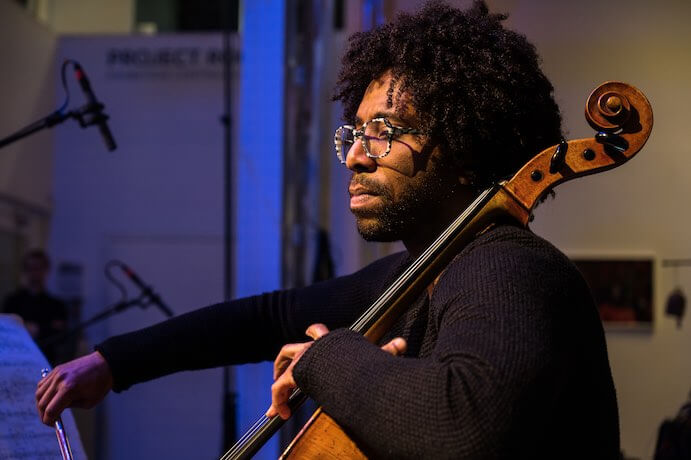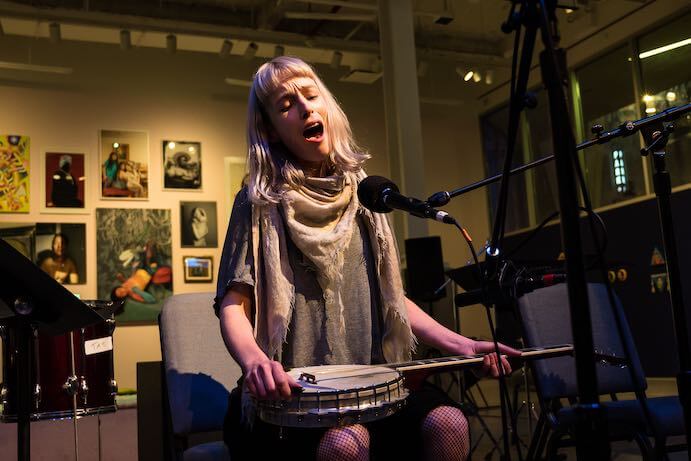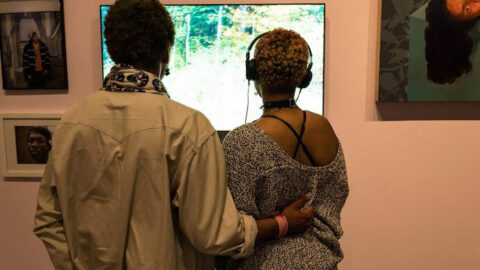When host Terrance McKnight asked cellist Seth Parker Woods what comes to mind when hearing the word justice, he simply stated: “new and honest stories.” The opening program of Look + Listen 2019 was titled “Justice” and evoked just that. Look + Listen is a festival that pairs new music and visual art, and the three sets on May 3 at BRIC House–along with the exhibit “The Portrait is Political” on the walls of the room–presented new and honest artistic stories from a range of individuals.
Parker Woods opened the program with three pieces for solo cello that each provided a different type of musical conversation. Nathalie Joachim’s Dam Mwen Yo (“these are my ladies”) combines the warm honesty of a solo cello with processed field recordings of Haitian women’s voices to create a rich tapestry of melody, history, empathy, and strength. As these layered melodies filled the room with communal song, the cello folded itself so naturally into this texture that it became one with the others. When the cello became the central focus, Parker Woods provided his own soulful melody, delivered with integrity, simplicity, and care. Chinary Ung’s Khse Buon followed, inspired by the vocalizations of Cambodian folk tunes. Ung fuses contemporary Western and Cambodian musical languages, beginning with slow repeated falls in and out of unison and a drone underneath to maintain a sense of grounding. An intricate but hesitant melody pushed the piece forward, with particular stylistic elements (glissandi, quivering trills) enabling the single voice to sound like it was in conversation with itself.

George Lewis’ Not Alone, an incredibly complex work written for Parker Woods in 2015 and dedicated to free-jazz cellist Abdul Wadud, featured interactive electronics that layered the sounds of multiple cellists to create spatially complex conversations. Whereas the first two conversations of the evening were empathetic and grounded, this one felt more chaotic and unresolved. Throughout the set, Parker Woods showcased the range and depth of his instrument through virtuosic performances that combined both technical prowess and delicate grace.
Charlotte Mundy (of the TAK Ensemble) began the second set with Doug Balliett’s Ozymandias, a reaction to Percy Shelley’s poem of the same name. This piece for solo voice and banjo utilizes all aspects of the human voice from spitting sounds to wicked cackles, bel canto singing to joyous laughter, pained coughing to wild screaming. Mundy delivered the story by alternating clear straight-toned singing with non-traditional vocal interjections, accompanied by occasional strumming or whacking of the banjo on her lap. Her ability to combine these vastly different vocalisms, utilizing every corner and crevice of her range, while also telling a story through a delicate melody, showcased not only her virtuosity, but also her commitment to experimentation and theatricality.

After Natacha Diels‘ Strange Attractors–a piece for piccolo, percussion, and electronics that uses cyclic beat patterns of impossibly high instruments–the full TAK Ensemble turned to experimental performance for the world premiere of Jessie Marino’s Portrait of a Lady with a Squirrel and a Starling, commissioned by Look + Listen 2019. Portrait began with all five performers sitting in a straight line, sharply moving their heads and arms in choreographed patterns, with clicks of the tongue, tapping on their laps, and stomping on the floor. Mundy narrated a powerpoint presentation (a la school report) on squirrels and starlings in a semi-robotic fashion with occasional sung interjections, accompanied by rhythmic interlockings of the violin, percussion, flute, and clarinet. At the end, the performers recited a poem in unison (supposedly written by Mozart for the death of his pet starling) with similar choreography as the opening. Marino’s unique combination of music, word, image, and absurd humor emphasized the TAK Ensemble’s commitment to questioning the rules of music and performance and their success in presenting it.
For the final set of the evening, composer-performer Angélica Negrón performed five ambient pop-songs featuring her unique electronics—a vegetable synthesizer (via the Ototo interface), and mechanical instruments (a plant atop a book, a glass vessel with water, a small metal disc) built by Nick Yulman. Negrón sang five songs in Spanish about the search for home, reflecting on her native Puerto Rico, with additional percussion by Shayna Dunkelman.

These miniature worlds shared certain qualities—gently sincere melodies, infectious rhythmic beats, intricate layering of electronic and acoustic percussion, the novelty of vegetables as instruments, and samples of found sounds. In each of the electroacoustic soundscapes, Negrón created a delicate and dreamy atmosphere, with the ethereality of her vocals providing a through current. While Negrón seems capable of making music from almost any object—a toy bell dunked into a vessel of water, a radish, dragonfruit, or cauliflower—it is her sincerity, her genuine commitment to performing songs in her distinctive voice, and her unique sound world that sets her apart.
From solo cello to vegetable synth, strummed banjo to musical performance art, the opening evening of Look + Listen brought to life countless new and honest stories. As we lived in this combined aural and visual experience, the curators of the exhibit and the musical performers provided examples of myriad ways to respond to, interact with, and engage the world around us.
























